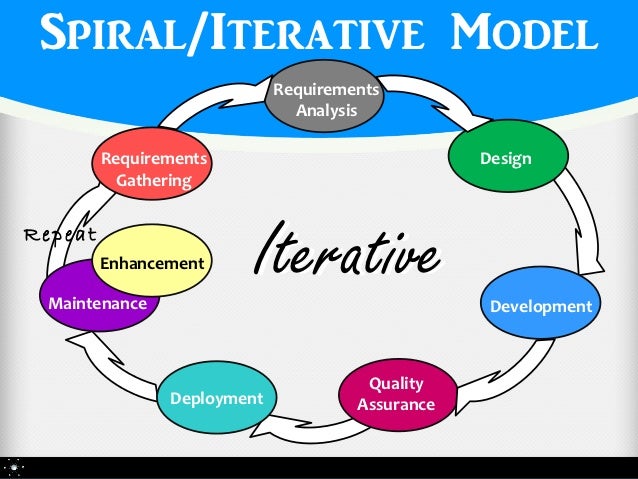Advantages Of Spiral Model In Software Testing

Software prototyping is the activity of creating prototypes of software applications, i.e., incomplete versions of the software program being developed. What is SDLC SPIRAL MODEL? This model is a combination of sequential and prototype model. This model is best used for large projects which involves continuous. SDLC Spiral Model - Learn Software Development Life Cycle starting with SDLC overview and covering various models like waterfall model, Iterative Model, Spiral Model. The objective of the spiral model is to emphasize management to evaluate and resolve risks in the software project. Different areas of risks in the software project.
What is Spiral model- advantages, disadvantages and when to use it? The spiral model is similar to the incremental model, with more emphasis placed on risk analysis. The spiral model has four phases: Planning, Risk Analysis, Engineering and Evaluation. A software project repeatedly passes through these phases in iterations (called Spirals in this model). The baseline spiral, starting in the planning phase, requirements are gathered and risk is assessed. Each subsequent spirals builds on the baseline spiral.
Its one of the software development models like Waterfall, Agile, V- Model. Planning Phase: Requirements are gathered during the planning phase. Requirements like . If any risk is found during the risk analysis then alternate solutions are suggested and implemented. Engineering Phase: In this phase software is developed, along with testing at the end of the phase. Hence in this phase the development and testing is done. Evaluation phase: This phase allows the customer to evaluate the output of the project to date before the project continues to the next spiral.
Diagram of Spiral model: Advantages of Spiral model: High amount of risk analysis hence, avoidance of Risk is enhanced. Good for large and mission- critical projects. Strong approval and documentation control. Additional Functionality can be added at a later date. Software is produced early in the software life cycle. Disadvantages of Spiral model: Can be a costly model to use. Risk analysis requires highly specific expertise.
What is SDLC Waterfall Model? Introduction: Waterfall model is an example of Sequential model. In this model, the software development activity is divided into.
Project’s success is highly dependent on the risk analysis phase. Doesn’t work well for smaller projects. When to use Spiral model: When costs and risk evaluation is important. For medium to high- risk projects. Long- term project commitment unwise because of potential changes to economic priorities. Users are unsure of their needs.
Study material for Foundation level, Premium & Free for ISTQB and ASTQB Exam, Certification questions, answers, software testing tutorials and more. Advantages of Agile model: Customer satisfaction by rapid, continuous delivery of useful software. People and interactions are emphasized rather than process and tools. To overcome disadvantages in Waterfall Model, the V-Model - Software Development Life Cycle(SDLC) is comes into the picture. It is always better to introduce testing. In the field of Software testing we use different types of Software Testing Methodologies. In today’s Software Testing Class, we will see what all Software Testing. The spiral model, also known as the spiral lifecycle model, is a systems development method (SDM) used in information technology (IT). This model of development.
Requirements are complex. New product line. Significant changes are expected (research and exploration). Download Game Money Tree Crack Filler.
Advantages and Disadvantages ~ I Answer 4 U. What is the Spiral Model?
It was first proposed by Boehm. In this system development method, we combine the features of both, waterfall model and prototype model. In Spiral model we can arrange all the activities in the form of a spiral. Each loop in a spiral represents a development phase (and we can have any number of loops according to the project).
Each loop has four sections or quadrants : 1. To determine the objectives, alternatives and constraints. We try to understand the product objectives, alternatives in design and constraints imposed because of cost, technology, schedule, etc. Risk analysis and evaluation of alternatives. Here we try to find which other approaches can be implemented in order to fulfill the identified constraints.
Operational and technical issues are addressed here. Risk mitigation is in focus in this phase. And evaluation of all these factors determines future action. Execution of that phase of development. In this phase we develop the planned product. Testing is also done. In order to do development, waterfall or incremental approach can be implemented.
Planning the next phase. Here we review the progress and judge it considering all parameters. Issues which need to be resolved are identified in this phase and necessary steps are taken. Subsequent loops of spiral model involve similar phases. Analysis and engineering efforts are applied in this model.
Large, expensive or complicated projects use this type of life cycle. If at any point of time one feels the risk involved in the project is a lot more than anticipated, one can abort it. Reviews at different phases can be done by an in- house person or by an external client. Both waterfall and prototype models are used in it. Here we do software development systematically over the loops (adhering to waterfall approach) and at the same time we make a prototype and show it to user after completion of various phase (just in case of prototype model). This way we are able to reduce risks as well as follow systematic approach. Now let’s discuss the advantages and disadvantages of Spiral Model in detail.
Development phases can be determined by the project manager, according to the complexity of the project. Each phase, as well as each loop, requires a review from concerned people. This makes the model more transparent.
And coping with these changes isn’t a very big headache for the project manager. Doing so, through- out the span of project is tough. We appreciate her hard work. You can check her article by clicking here(opens in new window).